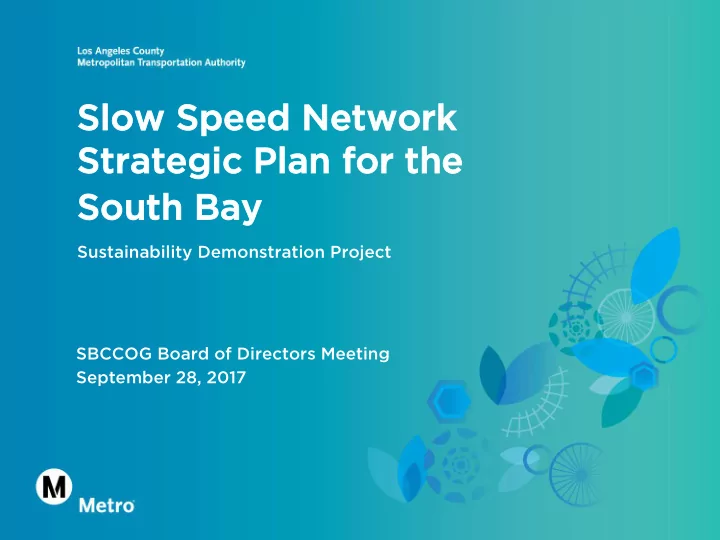

Slow Speed Network Slow Speed Network Strategic Plan for the Strategic Plan for the South Bay South Bay Sustainability Demonstration Project SBCCOG Board of Directors Meeting September 28, 2017
Project Goals Network strategy for low speed vehicles: Replicable demonstration of Countywide Sustainability Planning Policy: A feasible, economically viable, effective system that: A feasible, economically viable, effective system that: • Promotes neighborhood and regional connectivity. • Reduces GHG and pollution. • Increases health and safety. • Encourages a shift from cars to a wide range of green modes such as walking, biking, and all other zero-emissions non-car modes. • Makes the most of emerging technologies. • Develops methods for project evaluation based on performance measures identified in the Countywide Sustainability Planning Policy (CSPP).
Slow Speed Modes Pedestrians and Sidewalk Rolling Modes: Pedestrians and Sidewalk Rolling Modes: 0-12.5MPH 0-12.5MPH On-Street Rolling Modes: 12.5-25MPH On-Street Rolling Modes: 12.5-25MPH
Project Steps Network Principles Make the most of existing infrastructure. Differentiate the network from surroundings through wayfinding and branding. Make the network practical for accessing jobs, education, shopping, recreation and other destinations through slow modes.
Project Steps More Complete Complete Streets For widest range of slow sidewalk and on-street modes. More diverse the range of modes, the better for pedestrians and transit: roads not exclusively dominated by autos, making other transportation options safer and more viable.
Project Steps All modes share <25MPH roadway.
Project Steps NEVs Present potential benefits/challenges: Excellent for under 3 miles trips – but vulnerable if mixed with full speed cars. For commuting not just recreation. 65% of trips in South Bay are within the sub region, average below 7 minutes*. *Metro 2015 South Bay Cities Mobility Matrix. Approach to NEVs based on Lincoln CA NEV Plan
NEV lane on < = 35MPH NEV lane on < = 35MPH road can be shared with road can be shared with bikes and other slow bikes and other slow rolling modes. rolling modes. Google Car Roadway marking Roadway marking Lincoln, CA Lincoln, CA Polaris GEM
Project Steps 3 Interconnected Networks Local Sub-regional Regional Slow Zones On-street Slow Speed Network Thruways
Sub-regional Network Connects Slow Zones. Adapted from regional Active Transportation Network (ATN).
Facilities Class I Class I Class III Class III Class II Class II Class IV Class IV
Slow Zones Local Network San Pedro North Redondo El Segundo Hawthorne (& Nine Lite Slow Zones) Connected by Sub-regional network
North Redondo Slow Zone pt.1 Pedestrian area and adjacent regional destination accessible from South Bay Slow speed network On-street sub-regional network compact around pedestrian core.
North Redondo Slow Zone pt.2 Pedestrian area and adjacent regional destination accessible from South Bay Slow speed network On-street sub-regional network compact around pedestrian core.
North Redondo Slow Zone
Hawthorne Slow Zone
Low Speed Thruways Regional Network ROWs for non-car modes including NEVs ie: Dominguez Channel Hawthorne to the Port. 16 miles. Access from arterials, CalState Dominguez Hills, El Camino College, UCLA Harbor Med.
Multi-Modal Path Dominguez Channel For all slow modes including NEVs, bikes, pedestrians and others. Access points from arterial and local streets In RFP phase for widening
Project Steps Evaluation Framework Enumerates sidewalk and roadway improvements. Compares impact on sustainability between Slow Zones. 2025 Scenario demonstrates potential of switching to low speed zero emissions modes for 20% of short trips. 290 tons/day of CO2 = 30,000 gallons of gasoline.
Project Steps Potential Pilot Projects Rail to River Terminus to the Dominguez Channel, via Inglewood and Hawthorne
Project Steps Pilot Projects North Redondo Transit Center to El Camino College to Carson Slow Zone
Project Steps Pilot Projects El Segundo
Project Steps Pilot Projects San Pedro
Thank You Link to full report: https://media.metro.net/projects_studies/ sustainability/images/ Metro_SlowSpeedNetwork_2017-0920.pdf More info: info@civicprojects.org
Questions/Discussion
Recommend
More recommend